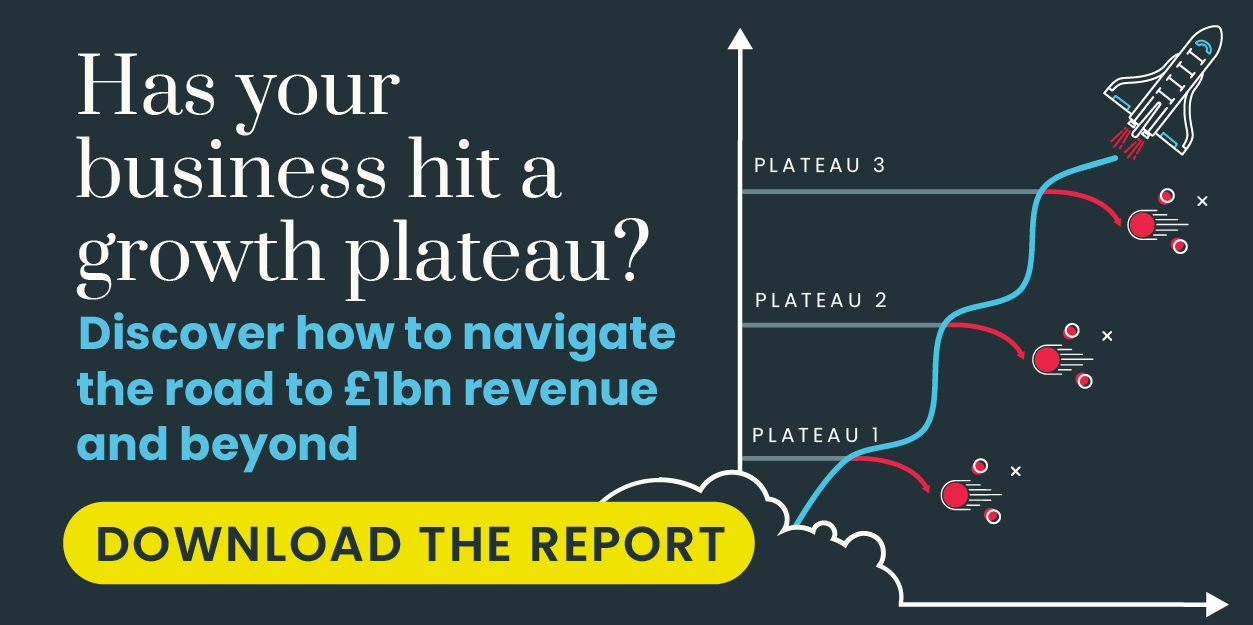Scaling a business beyond a growth plateau
"Beware the 3 growth plateaus when scaling a business to £1bn and beyond. By understanding where the danger zones lie; CEO's can help overcome these challenges and maintain their company growth."

The intrepid businesses that effectively navigate the journey from £50m revenue to £1bn deserve their success. Scaling a business is a hard-won voyage, especially in today’s volatile marketplace. There are perils at every turn.
Each of these high achievers will doubtless have stories – and even bear the battle scars – of the trials they encountered along the way to successfully deliver the business strategies required to scaling a business. For the audacious few that make it through to £1bn and beyond, there are many more that fall aside or are still fighting the odds. In fact, just 5% of businesses traverse to the other side with minimal impact. The rest will either see growth slow down, stall or go into reverse.
> READ THE RESEARCH: How to navigate your growth challenges on the road to £1bn
Global corporate performance today is more volatile than ever. On average, one in three publicly-listed companies will not exist in five years’ time – that a five-times increase compared to 50 years ago.
Prepare for the meteor showers
What if you could pre-empt the trouble? Companies can run out of road quicker than expected, hitting the buffers without the necessary time to brace for impact. Hindsight isn’t a whole lot of use.
Here’s a little foresight on us - Our research into the long-term performance of 1,500 UK businesses, sized between £50m and £1bn in revenue, reveals that when scaling up a business to £1bn and beyond, it is marked by three distinct hazards at which companies find growth more challenging to come by.
Entering these danger zones is often a natural course of action as companies evolve and scale. In some cases, they are unavoidable due to external factors. But they’re worth considering, given our analysis shows that one in two UK businesses are likely to experience at least one growth plateau as they scale.
The path to £1bn and beyond is never going to be an easy one, but these three points in that growth journey carry significantly greater risk.
GROWTH PLATEAU 1
- £75m - £125m in revenue
- 74% of all companies experience a significant slow-down in growth
What’s going on?
The most common challenge that businesses face at this revenue band is in professionalising their organisation. Making the transition from lean and focused to professional, secure and sustainable is a jolt to the status quo.
Investment in systems, people and governance all tend to increase around this stage, which often impacts margin, knocking capacity and confidence to invest.
Professionalisation may drive new ways of working, systems and processes which are all sound in their own right. But they may also reduce the focus on customer and product or make the business less efficient.
Moreover, this step from small- to mid-sized when scaling up a business typically involves leadership entrusting others with more accountability and requires a different mindset and different capabilities than the journey to £100m.
GROWTH PLATEAU 2
- £350m - £450m in revenue
- 51% of all companies experience either a stall or a decline in growth
What’s going on?
At this revenue band, the most common scale up challenge that businesses face is the necessity to drive effective expansion of their already very successful model. Growth needs to come from bolt-on acquisitions or international expansion, both of which carry risk.
This expansion exposes the business to different commercial and strategic dynamics. Flexibility is required to deliver different solutions for different parts of the business – a greater challenge than operating a business in accordance with a singular strategy.
There is significant scope for poor decisions, failure to effectively integrate new acquisitions and unsuccessful attempts to access new markets. A new strategic blueprint may be needed to help the company adapt.
GROWTH PLATEAU 3
- £650m - £750m in revenue
- 48% of all companies experience either a stall or a decline in growth
What’s going on?
As businesses scale up towards three-quarters of a billion in revenue, they enter a period of significant risk. These businesses have often expanded their core offering both domestically and internationally and have reached a point where they need to diversify to continue to grow.
This places greater emphasis on commercial, marketing and supply chain capabilities to develop and commercialise new product and/or service offerings to drive the business at scale.
Symptoms of this diversification can be a significant growth in operating expenditure, increased business complexity and loss of commercial controls – all of which can impact performance in both the core business and new ventures.
Every successful business is intent not just on surviving, but on truly thriving into the future. Way into the future. This means generating long-term, sustainable growth at scale.
Understanding the most likely danger zones can help maintain company growth as you scale up the business towards £1bn and beyond.
And now that you know when the growth plateaus are likely to arrive, it’s worth thinking about the most common triggers of decline.
> RELATED ARTICLE: Diagnose the growing pains that can stall company growth on the road to £1bn


